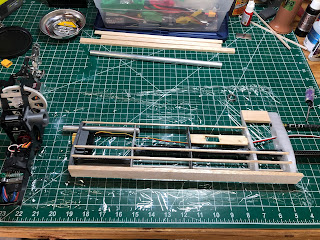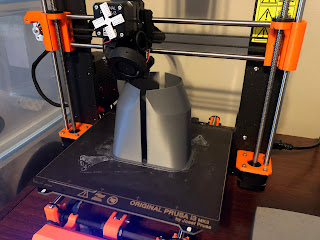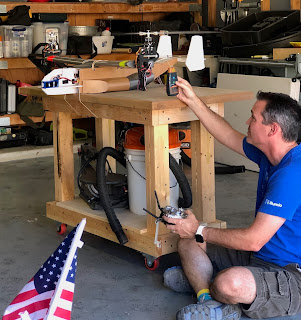V-22 Osprey Project - Yaw Problems on Initial Flight Tests
I had to take a pause on the initial flight tests for a few weeks while we had a new above ground pool installed and then built a deck to match it with the existing deck and house.
During a couple of spool-up tests on the V-22, I noticed a strong yaw tendency on the model. The yaw movement quickly turns into an out-of-control spin before I shut down the craft for safety. I've tried correcting it with control inputs, but they're not reactive enough. I have checked the control servos many times and verified they are working properly, so my next suspect is the rotor speeds themselves. It is possible that one of the rotors is not spinning at the same rate as the other and inducing a yaw motion.
The ESCs that I am using are the stock
Kylin-branded 40A ESCs that came with the donor helicopters. Because I purchased the helicopters a year apart, I am not surprised that they are not exactly the same. The capacitors and heat sinks on one are larger than the other and the startup beeps are a little different. I've gone through the initial setup and configured them each the same, but I wanted to verify that a speed difference exists before proceeding further.
I have a laser tachometer that I've used a few times before on other projects, but this measurement would get me dangerously close to whirling death-knives that are RC rotor blades. I started by configuring custom throttle and pitch curves to use during testing. The throttle curve is a standard -100 to 100 linear curve and the pitch curve was flat from -100 to 100 range to hold the blade position at 0 degrees as to not push or pull the model during these spin up tests. The rotor blades are standard RC helicopter blades with a fully-symmetric airfoil. Next, I physically restrained the model to my mobile workbench in the garage and began testing with one ESC at a time. I created a throttle to RPM chart for each rotor so I could build independent throttle curves if there is a difference.
As I started to spin up the first rotor on the bench, I noticed that the rotor blades were at about waist-level. It might be a sign of me getting older and possibly wiser, but it occurred to me that a catastrophic failure of the rotor head could send carbon fiber rotor bits into squishy parts of my body. I regrouped and grabbed the transmitter, the tachometer, and my throttle chart and huddled underneath the bench in a position where I could reach out and trigger the tach in a "safer" manner.
The test results were revealing:
I did not run the test from the full -100 to 100 throttle range as I was really only interested in achieving a head RPM of between 2500 and 3000. As you can see from the chart above, the right rotor lags the left by about 150 RPM at any given throttle position. Is this enough to induce the yaw that I was seeing? I'm not sure.
Another alternative would be to purchase new ESCs that have a helicopter governor mode. I've looked quite a bit at the Castle Creations
Talon 60 and
Phoenix Edge Lite 50 ESCs, but having to purchase 2 of these would set me back $150 to $200. I'm not prepared to do that quite yet.
With this new data in hand, I created separate left and right throttle curves and reduced the output of the left throttle curve about 6 points from the right. I will need to retest and see if the output is more closely aligned before I do another flight test.
Also, by separating the throttle outputs I no longer have enough output pins on my FrSky S8R receiver to connect everything. I do have an
S-bus to PWM decoder that I use on another airplane to get access to the additional channels. I'll borrow this device so I don't need to use any Y-cables for the ESC and tilt servos. This will also free up 2 ports on the S8R for something else should I need them later.
A note on the S-Bus decoder: It narrows the output band from the stock FrSky outputs. A -100 to 100 on the FrSky translates to approx. -80 to 80 on the Sbus output. I've had to enable extended trims/outputs on the transmitter to re-trim the tilt servos and ESC outputs.










